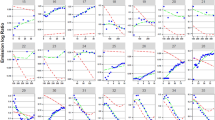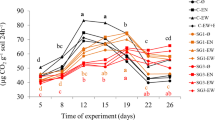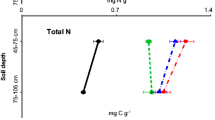Abstract
The influence of earthworms (Lumbricus terrestris and Aporrectodea tuberculata) on the rate of net N mineralization was studied, both in soil columns with intact soil structure (partly influenced by past earthworm activity) and in columns with sieved soil. Soil columns were collected from a well drained silt loam soil, and before the experiment all earthworms present were removed. Next, either new earthworms (at the rate of five earthworms per 1200 cm3, which was only slightly higher than field numbers and biomass) were added or they were left out. At five points in time, the columns were analyzed for NH +4 , NO −3 , and microbial biomass in separate samples from the upper and lower layers of the columns. N mineralization was estimated from these measurements. The total C and N content and the microbial biomass in the upper 5 cm of the intact soil columns was higher than in the lower layer. In the homogenized columns, the C and N content and the microbial biomass were equally divided over both layers. In all columns, the concentration of NH +4 was small at the start of the experiment and decreased over time. No earthworm effects on extractable NH +4 were observed. However, when earthworms were present, the concentration of NO −3 increased in both intact and homogenized cores. The microbial biomass content did not change significantly with time in any of the treatments. In both intact and homogenized soil, N mineralization increased when earthworms were present. Without earthworms, both type of cores mineralized comparable amounts of N, which indicates that mainly direct and indirect biological effects are responsible for the increase in mineralization in the presence of earthworms. The results of this study indicate that earthworm activity can result in considerable amounts of N being mineralized, up to 90 kg N ha−1 year−1, at the density used in this experiment.
Similar content being viewed by others
References
Anderson JM (1988) Spatiotemporal effects of invertebrates on soil processes. Biol Fertil Soils 6:216–227
Blair JM, Parmelee RW, Lavelle P (1995a) Influences of earthworms on biogeochemistry. In: Hendrix PF (ed) Earthworm ecology and biogeography in North America. Lewis Publishers. Boca Raton, Fla, pp 127–158
Blair JM, Bohlen PJ, Edwards CA, Stinner BR, McCartney DA, Allen MF (1995b) Manipulations of earthworm populations in field experiments in agroecosystems. Acta Zool Fenn 196:48–51
Blair JM, Allen MF, Parmelee RW, McCartney DA, Stinner BR (1996) Changes in soil N pools in response to earthworm population manipulations under different agroecosystem treatments. Soil Biol Biochem (in press)
Bohlen PJ, Parmelee RW, Blair JM, Edwards CA, Stinner BR (1995) Efficacy of methods for manipulating earthworm populations in large-scale field experiments in agroecosystems. Soil Biol Biochem 27:993–999
Brodus PC, Landman A, Pruden G, Jenkinson DS (1985) Chloroform fumigation and the release of soil nitrogen: a rapid direct extraction method to measure microbial biomass nitrogen in soil. Soil Biol Biochem 17:837–842
Christensen O (1988) The direct effects of earthworms on nitrogen turnover in cultivated soils. Ecol Bull (Stockholm) 39:41–44
Cortez J, Hameed R, Bouché MB (1989) C and N transfer in soil with and without earthworms fed with 14C- and 15N-labelled wheat straw. Soil Biol Biochem 4:491–497
Edwards CA, Lofty JR (1977) Biology of earthworms. Richard Clay Group, Suffolk
Elliot ET, Anderson RV, Coleman DC, Cole CV (1980) Habitable pore space and microbial trophic interactions. Oikos 35:327–335
Haimi J, Huhta V (1990) Effects of earthworms on decomposition processes in raw humus forest soil: A microcosm study. Biol Fertil Soils 10:178–183
Lavelle P (1988) Earthworm activity and the soil system. Biol Fertil Soils 6:237–251
Lee KE (1985) Earthworms: Their ecology and relationships with soils and land use. Academic Press, London
Nelson DW, Sommers LE (1932) Total carbon, organic carbon and organic matter. In: Page AL, Miller RH, Keeney DR (eds) Methods of soil analysis, part 2. ASA/SSSA Madison, Wisconsin, pp 539–579
Parle JN (1963) A microbial study of earthworm casts. J Gen Microbiol 31:13–22
Scheu S (1987a) Microbial activity and nutrient dynamics in earthworm casts. Biol Fertil Soils 5:230–234
Scheu S (1987b) The influence of earthworms on the nitrogen dynamics in the soil litter system of a deciduous forest. Oecologia (Berlin) 72:197–201
Syers JK, Springett JA (1984) Earthworms and soil fertility. Martinus Nijhoff, The Hague
Syers JK, Sharpley AN, Keeney DR (1979) Cycling of nitrogen by surface casting earthworms in a pasture ecosystem. Soil Biol Biochem 11:181–185
Van der Drift J, Witkamp M (1960) The significance of the breakdown of oak litter by Enoicola pusilla. Burm Arch Neerl Zool 13:486–492
Author information
Authors and Affiliations
Rights and permissions
About this article
Cite this article
Willems, J.J.G.M., Marinissen, J.C.Y. & Blair, J. Effects of earthworms on nitrogen mineralization. Biol Fertil Soils 23, 57–63 (1996). https://doi.org/10.1007/BF00335819
Received:
Issue Date:
DOI: https://doi.org/10.1007/BF00335819




